Contribution and Marginal Effects of Landscape Patterns on Thermal Environment: A Study Based on the BRT Model
Abstract
1. Introduction
2. Materials and Methods
2.1. Overall Technical Approach
2.2. Study Area
2.3. Data and Preprocessing
2.4. Indicator Construction
2.5. Vegetation Height Retrieval
2.6. Land Surface Temperature Retrieval
2.7. Sample Division and Classification
2.8. Statistical Analysis
2.8.1. Boosted Regression Tree (BRT) Model
2.8.2. Variance Partitioning Analysis
3. Results
3.1. LST Shows a “High in the Center, Low in the Surroundings” Wedge-Shaped Distribution
3.2. The Distribution Characteristics of Landscape Metrics Are Generally Obvious
3.2.1. Distribution Characteristics of Building Metrics
- (1)
- High in the Center, Low in the Surroundings
- (2)
- Low in the Center, High in the Surroundings
- (3)
- No Obvious Characteristics
3.2.2. Distribution Characteristics of Vegetation Metrics
- (1)
- Indicators Also Showing “Low in the Center, High in the Surroundings”
- (2)
- No Obvious Characteristics
3.3. Dominant Impact Indicators on LST under Separate and Combined Building and Vegetation Scenarios
3.3.1. Contribution and Dominant Indicators of Each Metric
3.3.2. Trends and Correlations
3.4. Differences in Indicator Contribution and Marginal Effects under Different Height Scenarios
3.4.1. Changes in Dominant Indicators
3.4.2. Marginal Effects
4. Discussion
4.1. How Do Two-Dimensional and Three-Dimensional Urban Building and Vegetation Patterns Specifically Affect LST?
4.1.1. Specific Impact of Two-Dimensional and Three-Dimensional Urban Building Patterns on LST
4.1.2. Specific Impact of Two-Dimensional and Three-Dimensional Urban Vegetation Characteristics on LST
4.1.3. Combined Impact of Two-Dimensional and Three-Dimensional Building and Vegetation Patterns on LST
4.2. How Do Various Indicators Affect LST under Different Building Heights?
4.2.1. Changes in Indicator Importance and Reasons
4.2.2. Changes in Marginal Effect Thresholds
4.3. Advantages and Limitations
5. Conclusions
- (1)
- When considering only the impact of building patterns on LST, three-dimensional building indicators have slightly higher explanatory power for LST than two-dimensional building indicators. Still, the two-dimensional building indicator PLAND_B remains the most important positive impact indicator for LST. When considering only the impact of vegetation, the overall explanatory power of two-dimensional vegetation indicators is higher than that of three-dimensional indicators. Still, the three-dimensional indicator TGI is the most significant contributor to LST.
- (2)
- When considering the combined impact of buildings and vegetation, building pattern indicators still have substantial explanatory power, and vegetation pattern characteristics have a lesser role in the urban thermal environment compared to building pattern characteristics. Additionally, building landscape patterns can affect the cooling benefits of vegetation landscape patterns on the urban thermal environment. In contrast, the impact of buildings on the urban thermal environment is less influenced by vegetation. When considering the combined impact of buildings and vegetation, the importance of two-dimensional vegetation indicators in regulating the urban thermal environment increases due to the influence of building patterns, indicating that horizontal vegetation patch coverage plays a more critical role in regulating the urban thermal environment compared to height characteristics.
- (3)
- Differences in building heights significantly impact the contribution of each indicator. In areas with lower building heights, PLAND_B and SHDI_B consistently rank among the top five dominant indicators. As height increases from BH1 to BH3, the warming effect of PLAND_B decreases while the warming effect of SHDI_B increases, highlighting the importance of controlling the diversity of building heights in such height variations. In areas with higher building heights, the vegetation indicators TGI, PLAND_V, PD_V, SHDI_V, and VHSD rank among the top five contributors to LST, with vegetation indicators dominating. As building height increases, the cooling turning point for PLAND_V occurs earlier, the threshold rises, and the cooling effect worsens. Therefore, in BH1, increasing PLAND_V can achieve a good cooling effect, while in higher areas, enhancing other vegetation indicators can strengthen the cooling effect.
Author Contributions
Funding
Data Availability Statement
Conflicts of Interest
References
- IPCC-Special-Report. 2024. Available online: https://www.ipcc.ch/site/assets/uploads/sites/2/2019/09/IPCC-Special-Report-1.5-SPM_zh.pdf (accessed on 29 May 2024).
- Manley, G. On the frequency of snowfall in metropolitan England. Q. J. R. Meteorol. Soc. 1958, 84, 70–72. [Google Scholar] [CrossRef]
- Kalnay, E.; Cai, M. Corrigendum: Impact of Urbanization and Land-Use Change on Climate. Nature 2003, 423, 528–531. [Google Scholar] [CrossRef] [PubMed]
- Campbell, S.; Remenyi, T.A.; White, C.J.; Johnston, F.H. Heatwave and Health Impact Research: A Global Review. Health Place 2018, 53, 210–218. [Google Scholar] [CrossRef] [PubMed]
- Chen, S.; REN, H.; YE, X.; Dong, J.; Zheng, Y. Geometry and adjacency effects in urban land surface temperature retrieval from high-spatial-resolution thermal infrared images. Remote Sens. Environ. 2021, 262, 112518. [Google Scholar] [CrossRef]
- Kasimu, A.; Zhang, X.; Liang, H. The spatial relationship between seasonal surface temperature and landscape pattern of the urban agglomeration on the northern slope of the Tianshan Mountains. Geogr. Res. 2024, 43, 1267–1287. [Google Scholar]
- Meng, D.; Li, X.; Gong, H.; Zhao, W. The thermal environment landscape pattern and typical urban landscapes effect linked with thermal environment in Beijing. Acta Ecol. Sin. 2010, 30, 3491–3500. [Google Scholar]
- Xiang, Y.; Zhou, Z. Influence of blue-green spatial landscape pattern on urban heat island. Chin. Landsc. Archit. 2023, 39, 105–110. [Google Scholar] [CrossRef]
- Peng, J.; Xie, P.; Liu, Y.; Ma, J. Urban Thermal Environment Dynamics and Associated Landscape Pattern Factors: A Case Study in the Beijing Metropolitan Region. Remote Sens. Environ. 2016, 173, 145–155. [Google Scholar] [CrossRef]
- Chen, A.; Sun, R.; Chen, L. Applicability of traditional landscape metrics in evaluating urban heat island effect. Chin. J. Appl. Ecol. 2012, 23, 2077–2086. [Google Scholar] [CrossRef]
- Huang, H.; Yun, Y.; Zhao, R. Key Parameters in Urban Form Layout for WeakeningUrban Heat Island Intensity and Its Response Mechanism. J. Civ. Archit. Environ. Eng. 2014, 36, 95–102. [Google Scholar]
- Zhou, W.; Huang, G.; Cadenasso, M.L. Does Spatial Configuration Matter? Understanding the Effects of Land Cover Pattern on Land Surface Temperature in Urban Landscapes. Landsc. Urban Plan. 2011, 102, 54–63. [Google Scholar] [CrossRef]
- Yu, X.; Xu, G.; Liu, Y.; Xiao, Y. Influences of 3D features of buildings on land surface temperature: A case study in the Yangtze River Delta urban agglomeration. China Environ. Sci. 2021, 41, 5806–5816. [Google Scholar] [CrossRef]
- Guo, F.; Wu, Q.; Schlink, U. 3D Building Configuration as the Driver of Diurnal and Nocturnal Land Surface Temperatures: Application in Beijing’s Old City. Build. Environ. 2021, 206, 108354. [Google Scholar] [CrossRef]
- Jiang, Y.; Li, Y.; Shi, T.; Han, X. The Simulation of Thermal Environment and Ecological Energy Conservation in Urban Residential Areas. J. Shenyang Jianzhu Univ. 2018, 34, 1145–1152. [Google Scholar]
- Srivanit, M.; Kazunori, H. The Influence of Urban Morphology Indicators on Summer Diurnal Range of Urban Climate in Bangkok Metropolitan Area. Thailand. Int. J. Civ. Environ. Eng. 2011, 11, 34–46. [Google Scholar]
- Xu, H.; Li, C.; Hu, Y.; Li, S.; Kong, R.; Zhang, Z. Quantifying the Effects of 2D/3D Urban Landscape Patterns on Land Surface Temperature: A Perspective from Cities of Different Sizes. Build. Environ. 2023, 233, 110085. [Google Scholar] [CrossRef]
- Luo, P.; Yu, B.; Li, P.; Liang, P.; Zhang, Q.; Yang, L. Understanding the Relationship between 2D/3D Variables and Land Surface Temperature in Plain and Mountainous Cities: Relative Importance and Interaction Effects. Build. Environ. 2023, 245, 110959. [Google Scholar] [CrossRef]
- Liao, J.; Tan, X.; Li, J. Evaluating the Vertical Cooling Performances of Urban Vegetation Scenarios in a Residential Environment. J. Build. Eng. 2021, 39, 102313. [Google Scholar] [CrossRef]
- Liu, M.; Ma, J.; Zhou, R.; Li, C.; Li, D.; Hu, Y. High-Resolution Mapping of Mainland China’s Urban Floor Area. Landsc. Urban Plan. 2021, 214, 104187. [Google Scholar] [CrossRef]
- Alavipanah, S.; Schreyer, J.; Haase, D.; Lakes, T.; Qureshi, S. The Effect of Multi-Dimensional Indicators on Urban Thermal Conditions. J. Clean. Prod. 2018, 177, 115–123. [Google Scholar] [CrossRef]
- Zhou, W.; Tian, Y. Effects of urban three-dimensional morphology on thermal environment: A review. Acta Ecol. Sin. 2020, 40, 416–427. [Google Scholar]
- Alexander, C. Influence of the Proportion, Height and Proximity of Vegetation and Buildings on Urban Land Surface Temperature. Int. J. Appl. Earth Obs. Geoinf. 2021, 95, 102265. [Google Scholar] [CrossRef]
- Hu, X.; Yan, H.; Wang, D.; Zhao, Z.; Zhang, G.; Lin, T.; Ye, H. A Promotional Construction Approach for an Urban Three-Dimensional Compactness Model-Law-of-Gravitation-Based. Sustainability 2020, 12, 6777. [Google Scholar] [CrossRef]
- Bai, X.; Wang, W.; Lin, Z.; Zhang, Y.; Wang, K. Three—dimensional measuring for green space based on high spatial resolution remote sensing images. Remote Sens. Land Resour. 2019, 31, 53–59. [Google Scholar]
- Shuai, M.; Xie, Y.; Yang, P. Research on the classification of high-resolution remote sensing images based on eCognition. Wirel. Internet Technol. 2018, 15, 98–99. [Google Scholar]
- Chang, Y.; Xiao, J.; Li, X.; Middel, A.; Zhang, Y.; Gu, Z.; Wu, Y.; He, S. Exploring Diurnal Thermal Variations in Urban Local Climate Zones with ECOSTRESS Land Surface Temperature Data. Remote Sens. Environ. 2021, 263, 112544. [Google Scholar] [CrossRef]
- Li, Z.; Hu, D. Exploring the Relationship between the 2D/3D Architectural Morphology and Urban Land Surface Temperature Based on a Boosted Regression Tree: A Case Study of Beijing, China. Sustain. Cities Soc. 2022, 78, 103392. [Google Scholar] [CrossRef]
- Elith, J.; Leathwick, J.R.; Hastie, T. A Working Guide to Boosted Regression Trees. J. Anim. Ecol. 2008, 77, 802–813. [Google Scholar] [CrossRef] [PubMed]
- Yu, Q.; Ji, W.; Prihodko, L.; Ross, C.W.; Anchang, J.Y.; Hanan, N.P. Study Becomes Insight: Ecological Learning from Machine Learning. Methods Ecol Evol 2021, 12, 2117–2128. [Google Scholar] [CrossRef]
- Ren, S.; Wang, T.; Guenet, B.; Liu, D.; Cao, Y.; Ding, J.; Smith, P.; Piao, S. Projected Soil Carbon Loss with Warming in Constrained Earth System Models. Nat Commun 2024, 15, 102. [Google Scholar] [CrossRef]
- Liu, S.; García-Palacios, P.; Tedersoo, L.; Guirado, E.; Van Der Heijden, M.G.A.; Wagg, C.; Chen, D.; Wang, Q.; Wang, J.; Singh, B.K.; et al. Phylotype Diversity within Soil Fungal Functional Groups Drives Ecosystem Stability. Nat. Ecol. Evol. 2022, 6, 900–909. [Google Scholar] [CrossRef]
- Chen, J.; Zhan, W.; Du, P.; Li, L.; Li, J.; Liu, Z.; Huang, F.; Lai, J.; Xia, J. Seasonally Disparate Responses of Surface Thermal Environment to 2D/3D Urban Morphology. Build. Environ. 2022, 214, 108928. [Google Scholar] [CrossRef]
- Zeng, P.; Sun, F.; Liu, Y.; Tian, T.; Wu, J.; Dong, Q.; Peng, S.; Che, Y. The Influence of the Landscape Pattern on the Urban Land Surface Temperature Varies with the Ratio of Land Components: Insights from 2D/3D Building/Vegetation Metrics. Sustain. Cities Soc. 2022, 78, 103599. [Google Scholar] [CrossRef]
- Wang, Q.; Wang, X.; Meng, Y.; Zhou, Y.; Wang, H. Exploring the Impact of Urban Features on the Spatial Variation of Land Surface Temperature within the Diurnal Cycle. Sustain. Cities Soc. 2023, 91, 104432. [Google Scholar] [CrossRef]
- Han, S.; Hou, H.; Estoque, R.C.; Zheng, Y.; Shen, C.; Murayama, Y.; Pan, J.; Wang, B.; Hu, T. Seasonal Effects of Urban Morphology on Land Surface Temperature in a Three-Dimensional Perspective: A Case Study in Hangzhou, China. Build. Environ. 2023, 228, 109913. [Google Scholar] [CrossRef]
- Sun, F.; Liu, M.; Wang, Y.; Wang, H.; Che, Y. The Effects of 3D Architectural Patterns on the Urban Surface Temperature at a Neighborhood Scale: Relative Contributions and Marginal Effects. J. Clean. Prod. 2020, 258, 120706. [Google Scholar] [CrossRef]
- Huang, Y.; Tu, R.; Tuerxun, W.; Jia, X.; Zhang, X.; Chen, X. A Community Information Model and Wind Environment Parametric Simulation System for Old Urban Area Microclimate Optimization: A Case Study of Dongshi Town, China. Buildings 2024, 14, 832. [Google Scholar] [CrossRef]
- Chen, Y.; Yang, J.; Yu, W.; Ren, J.; Xiao, X.; Xia, J.C. Relationship between Urban Spatial Form and Seasonal Land Surface Temperature under Different Grid Scales. Sustain. Cities Soc. 2023, 89, 104374. [Google Scholar] [CrossRef]
- Chen, X.; Zhao, P.; Hu, Y.; Ouyang, L.; Zhu, L.; Ni, G. Canopy Transpiration and Its Cooling Effect of Three Urban Tree Species in a Subtropical City- Guangzhou, China. Urban For. Urban Green. 2019, 43, 126368. [Google Scholar] [CrossRef]
- Anderson, M.C.; Kustas, W.P.; Norman, J.M.; Diak, G.T.; Hain, C.R.; Gao, F.; Yang, Y.; Knipper, K.R.; Xue, J.; Yang, Y.; et al. A Brief History of the Thermal IR-Based Two-Source Energy Balance (TSEB) Model—Diagnosing Evapotranspiration from Plant to Global Scales. Agric. For. Meteorol. 2024, 350, 109951. [Google Scholar] [CrossRef]
- Shen, X.; Liu, H.; Yang, X.; Zhou, X.; An, J.; Yan, D. A Data-Mining-Based Novel Approach to Analyze the Impact of the Characteristics of Urban Ventilation Corridors on Cooling Effect. Buildings 2024, 14, 348. [Google Scholar] [CrossRef]
- Chan, A.T.; Au, W.T.W.; So, E.S.P. Strategic Guidelines for Street Canyon Geometry to Achieve Sustainable Street Air Quality-Part II: Multiple Canopies and Canyons. Atmos. Environ. 2003, 37, 2761–2772. [Google Scholar] [CrossRef]
- Sodoudi, S.; Zhang, H.; Chi, X.; Müller, F.; Li, H. The Influence of Spatial Configuration of Green Areas on Microclimate and Thermal Comfort. Urban For. Urban Green. 2018, 34, 85–96. [Google Scholar] [CrossRef]
- Han, G.; Cai, Z.; Xie, Y.; Zeng, W. Correlation between urban construction and urban heat island A case study in Kaizhou District, Chongqing. J. Chongqing Jianzhu Univ. 2016, 38, 138–147. [Google Scholar]
- Yang, Y.; Zhang, Z.; Yu, X. A Comparative Study of Pedestrian-Level Wind Environment Based on a Standard Urban Building Model. J. Tongji Univ. 2022, 50, 784–792. [Google Scholar]
- Liu, W.; Gong, A.; Zhou, J.; Zhan, W. Investigation on Relationships between Urban Building Materials and Land Surface Temperature through a Multi-resource Remote Sensing Approach. Remote Sens. Inf. 2011, 46–53, 110. [Google Scholar]
- Schiano-Phan, R.; Weber, F.; Santamouris, M. The Mitigative Potential of Urban Environments and Their Microclimates. Buildings 2015, 5, 783–801. [Google Scholar] [CrossRef]

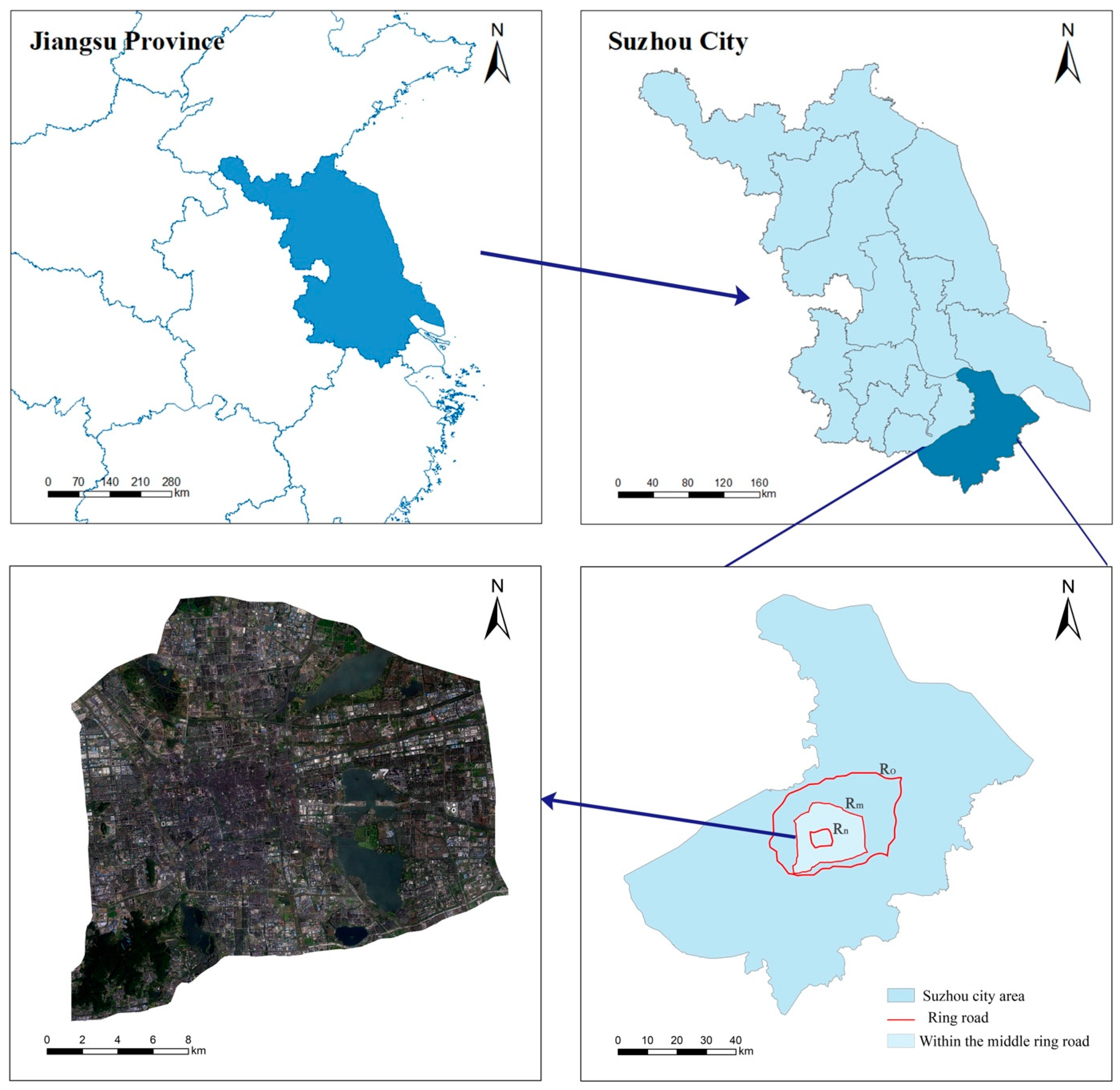
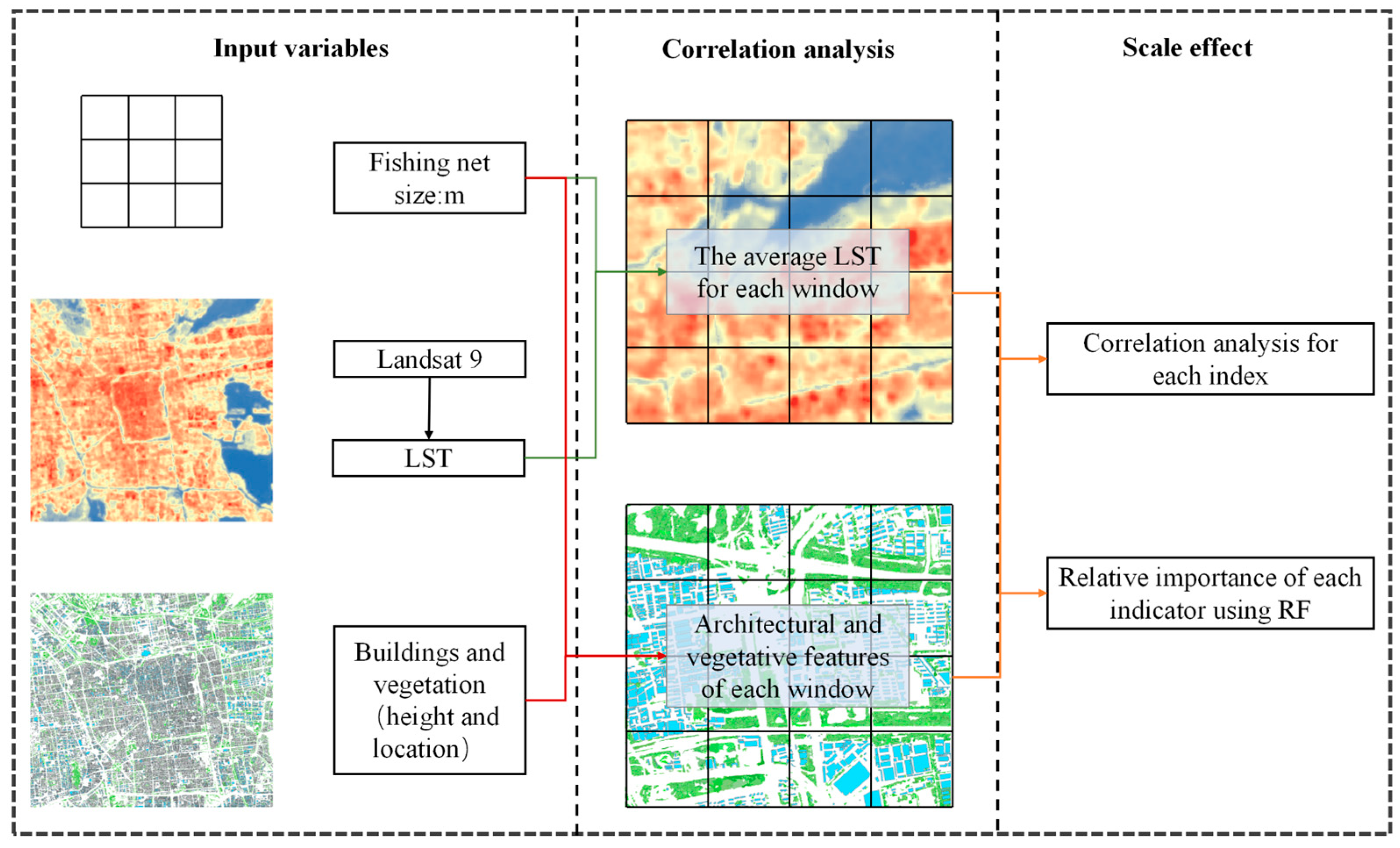


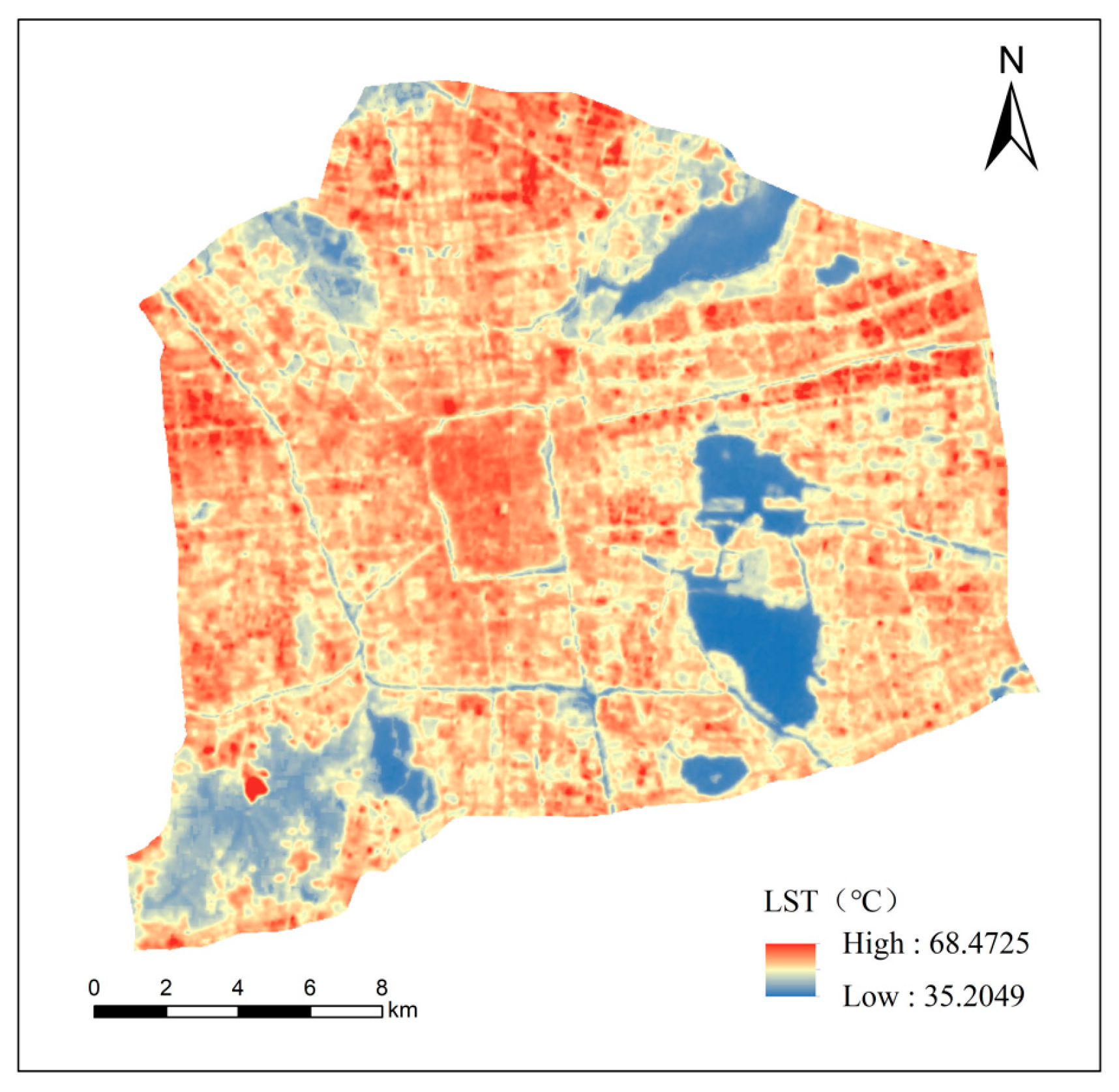

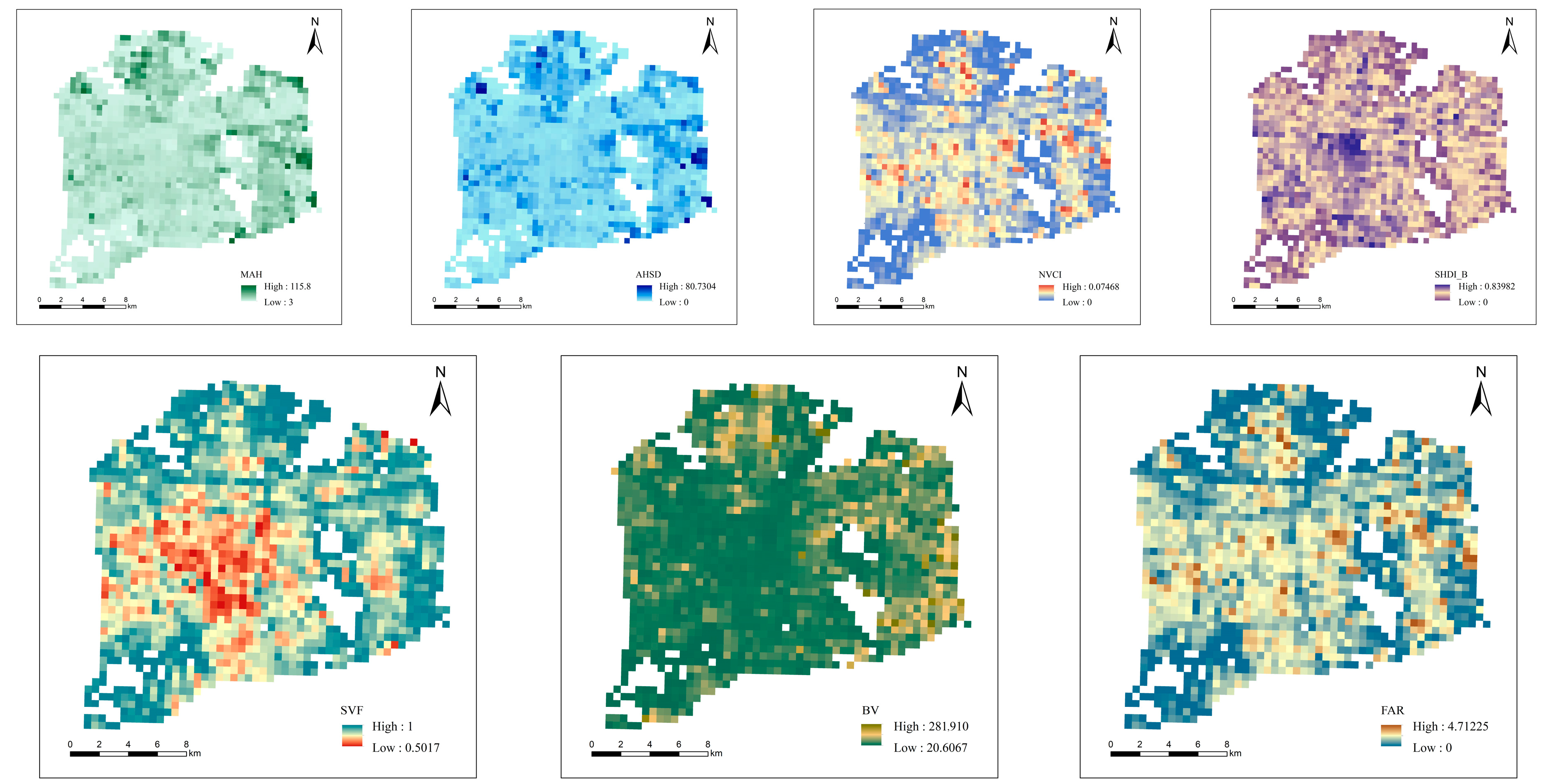



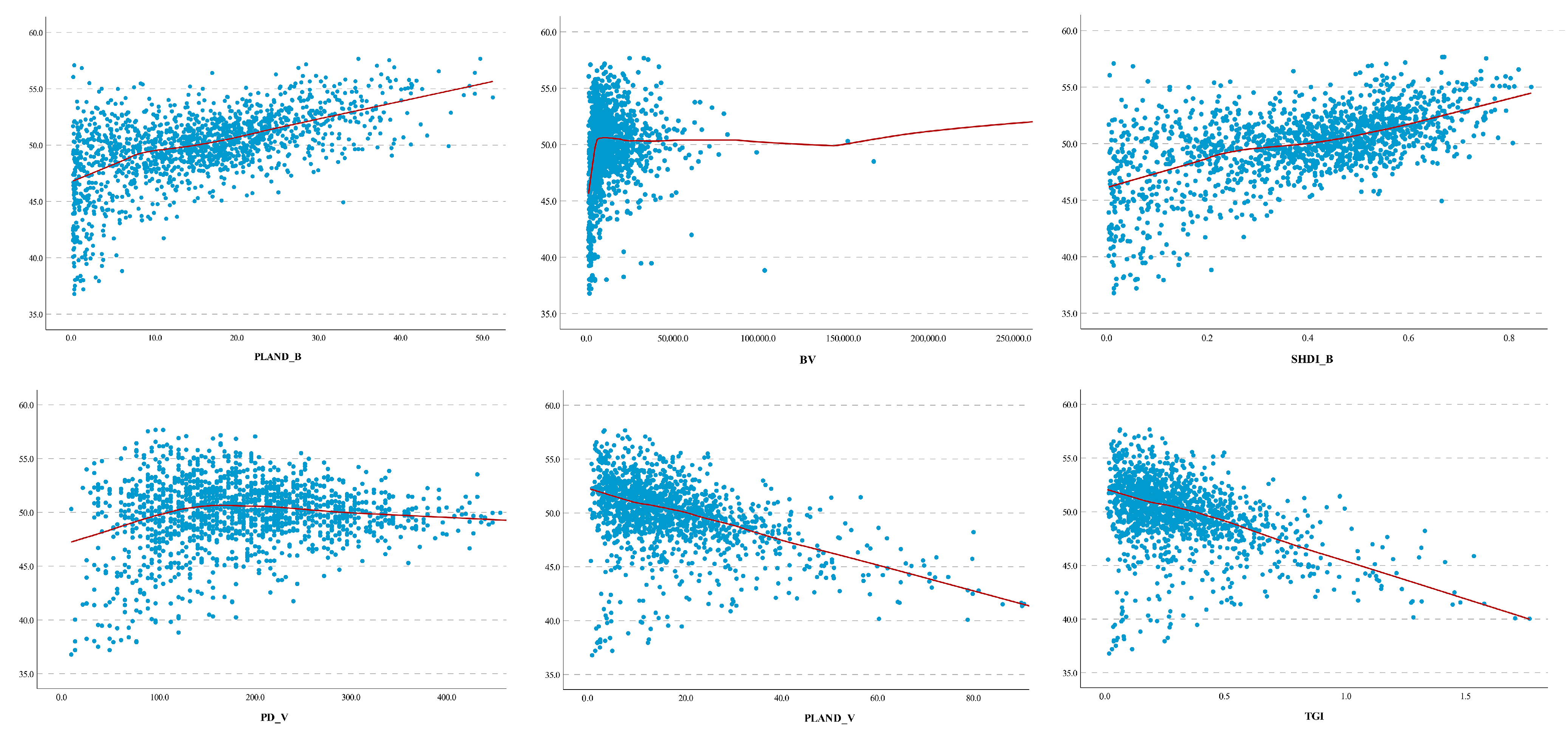

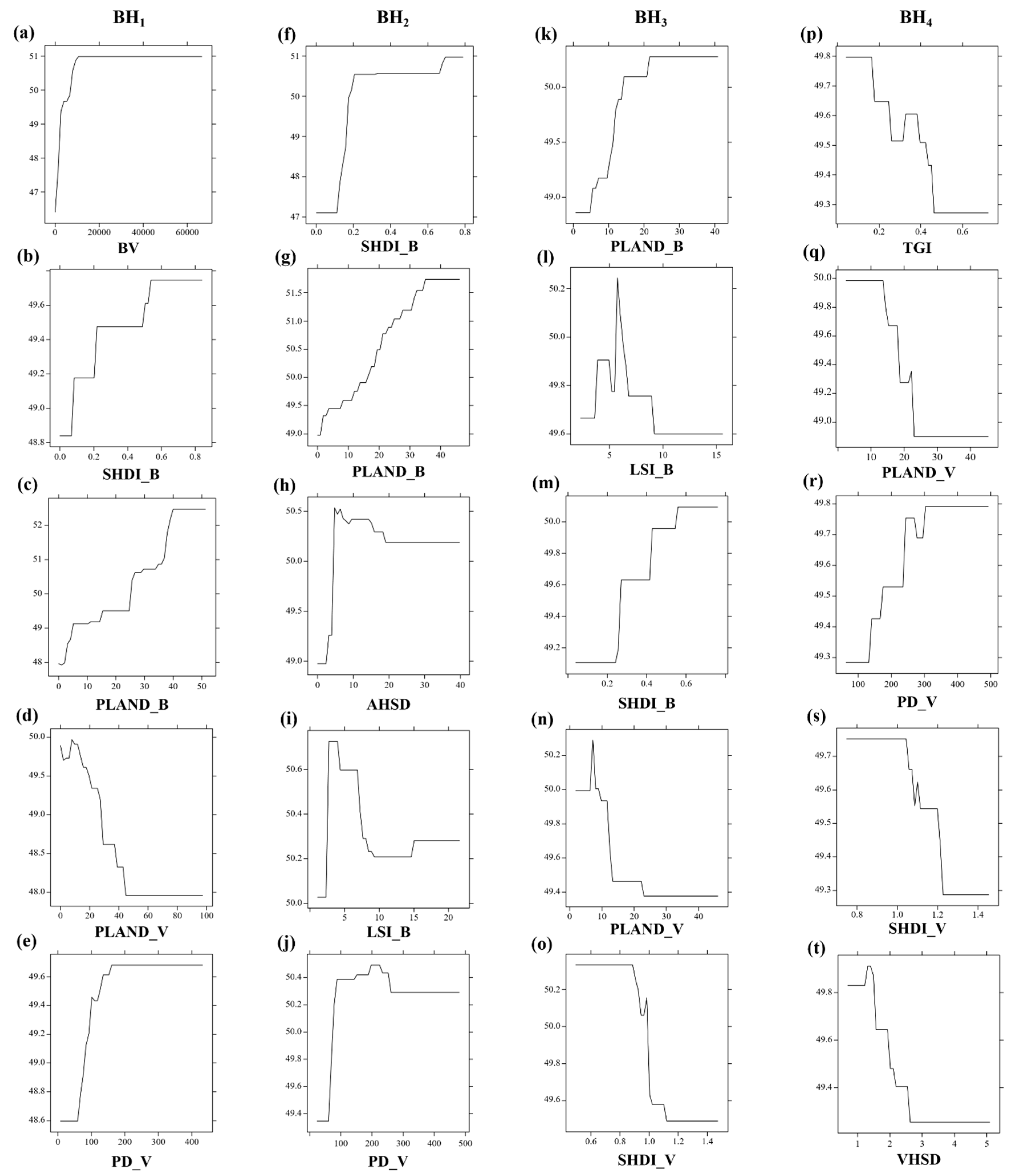

| Data | Type | Source |
|---|---|---|
| Remote sensing images | Raster data (0.8 m) | GF-2 |
| LST data | Raster data (100 m) | Landsat 9 OLI/TIRS |
| Building height data | Vector data | Baidumap |
| Landscape Metrics | Abbreviation | Category | Formula | Description |
|---|---|---|---|---|
| Percentage of landscape | PLAND, % | 2D | F: The land area of building/vegetation (m2) A: Study area (m2) | |
| Edge density | ED | 2D | n: Number of patches within the statistical unit ej: Total edge length of building/vegetation patches | |
| Patch density | PD | 2D | ni: Number of patches | |
| Landscape shape index | LSI | 2D | ej: Total edge length of building/vegetation patches min ej: Minimum total length of the edge in each patch | |
| Mean architecture/vegetation height | MAH/MVH, m | 3D | Hi: Architecture/vegetation height | |
| Mean architecture height standard deviation | AHSD/ VHSD, m | 3D | MH: Mean architecture/vegetation height (m) | |
| Floor area ratio | FAR, % | 3D | C: Number of floors | |
| Building volume | BV | 3D | Fi: The land area of building (m2) Hi: Architecture/vegetation height | |
| Three-dimensional green index | TGI | 3D | Ci: Height level corresponding to the i-th vegetation pixel in the study area Si: Actual area corresponding to the i-th vegetation pixel (m2) ∑ Ci Si: Equivalent base green vegetation area | |
| Shannon’s diversity index | SHDI | 3D | Pi: The proportion of the landscape occupied by patch type i | |
| Sky view factor | SVF | 3D | n: Number of calculated azimuth angles | |
| Normalized 3D compactness index | NVCI | 3D | d(i,j): The geometric distance between centroids of urban cube i and cube j d(i′,j′): The distance between cube i′ and j′ Vi and Vj: The volume of urban buildings in urban cube i and cube j Vi′ and Vj′: The volumes of the equivalent spheres in cubes i′ and j′ Q′: The total number of cubes which the equivalent sphere occupies N: The number of all cubes |
| Scenario | Description | Sample Size |
|---|---|---|
| BH1 | <10 m | 624 |
| BH2 | 10–20 m | 596 |
| BH3 | 20–35 m | 219 |
| BH4 | >35 m | 100 |
| Landscape Metric | PLAND_B | SHDI_B | BV | PLAND_V | PD_V | TGI |
|---|---|---|---|---|---|---|
| Correlation coefficient | 0.573 ** | 0.570 ** | 0.116 * | −0.424 ** | 0.129 ** | −0.417 ** |
| Value of ‘p’ | <0.001 | <0.001 | <0.01 | <0.001 | <0.001 | <0.001 |
Disclaimer/Publisher’s Note: The statements, opinions and data contained in all publications are solely those of the individual author(s) and contributor(s) and not of MDPI and/or the editor(s). MDPI and/or the editor(s) disclaim responsibility for any injury to people or property resulting from any ideas, methods, instructions or products referred to in the content. |
© 2024 by the authors. Licensee MDPI, Basel, Switzerland. This article is an open access article distributed under the terms and conditions of the Creative Commons Attribution (CC BY) license (https://creativecommons.org/licenses/by/4.0/).
Share and Cite
Li, T.; Huang, X.; Guo, H.; Hong, T. Contribution and Marginal Effects of Landscape Patterns on Thermal Environment: A Study Based on the BRT Model. Buildings 2024, 14, 2388. https://doi.org/10.3390/buildings14082388
Li T, Huang X, Guo H, Hong T. Contribution and Marginal Effects of Landscape Patterns on Thermal Environment: A Study Based on the BRT Model. Buildings. 2024; 14(8):2388. https://doi.org/10.3390/buildings14082388
Chicago/Turabian StyleLi, Taojun, Xiaohui Huang, Hao Guo, and Tingting Hong. 2024. "Contribution and Marginal Effects of Landscape Patterns on Thermal Environment: A Study Based on the BRT Model" Buildings 14, no. 8: 2388. https://doi.org/10.3390/buildings14082388
APA StyleLi, T., Huang, X., Guo, H., & Hong, T. (2024). Contribution and Marginal Effects of Landscape Patterns on Thermal Environment: A Study Based on the BRT Model. Buildings, 14(8), 2388. https://doi.org/10.3390/buildings14082388






